Sous Vide Cooking: What Is Sous Vide?
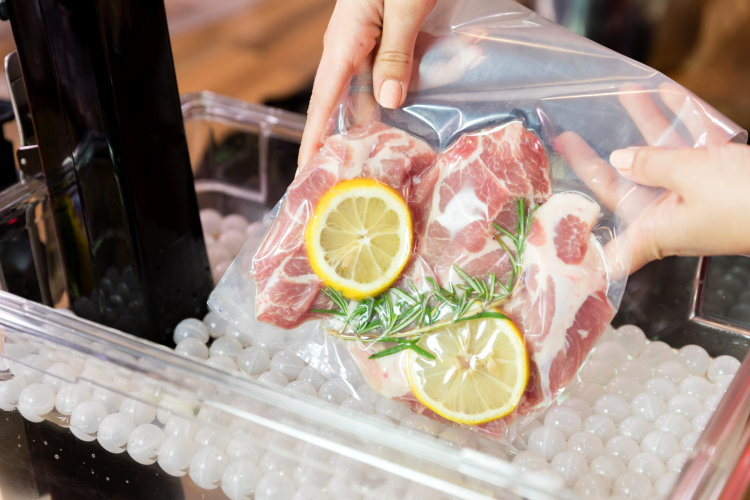
Sous vide cooking may conjure images of elite French restaurants or cooking competition shows, but with the right equipment and know-how, this culinary technique can easily be utilized at home.
Once reserved for professional chefs trying to efficiently prepare for the dinner rush, the accessibility of easy-to-use sous vide equipment has opened up sous vide cooking to home cooks interested in exploring this science-based technique.
What is sous vide cooking and what do you need to get started? Learning how to sous vide is a fun and easy way to elevate dishes at home.
With just a few accessories, home cooks can practice sous vide cooking in their own kitchens, using this technique to prepare everything from juicy, marinated proteins to tender, infused vegetables.
- What Is Sous Vide?
- Essential Sous Vide Cookware
- Benefits of Sous Vide Cooking
- Best Things to Sous Vide
- Common Sous Vide Mistakes
What Is Sous Vide?
Sous vide, which translates to “under vacuum” in French, refers to the process of sealing food in an airtight container, often a vacuum-sealed bag, and then gently cooking the food in temperature-controlled water.
There is no contact with direct heat or a metal surface, so the food cooks evenly and at a sustained temperature over a period of time. This process has long been used in professional kitchens to consistently prepare meats, seafood or vegetables to a precise temperature as they wait to be finished and served.
A sous vide machine uses a heated metal coil to warm the water and hold it at a constant temperature for a gradual, controlled cooking process. The machine also provides water circulation to eliminate hot or cold spots, resulting in an even cook throughout the product.
Thanks to steady temperatures and water circulation, sous vide cooking takes the guesswork out of preparing proteins like steak or chicken. Despite taking longer to cook, the process ensures that the protein will not be over or undercooked, producing uniform results without the need for meat thermometers or the poke test. The sous vide cooking method is time-saving and efficient, allowing chefs to quickly finish prepared proteins while guaranteeing a consistent cook every time.
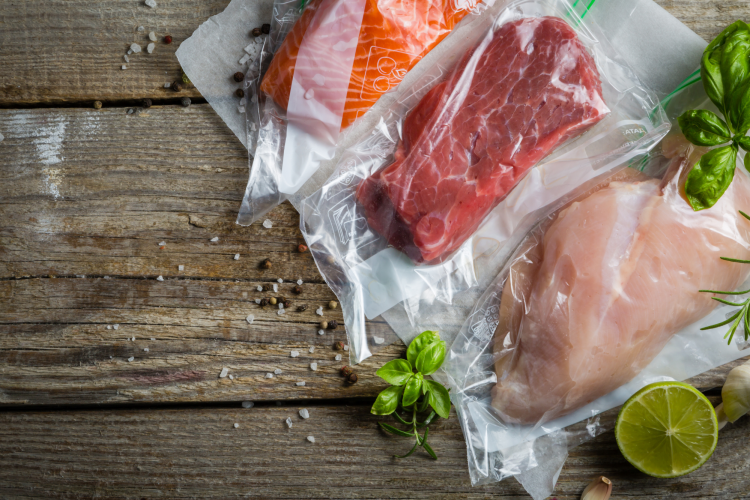
Essential Sous Vide Cookware
What tools do you need to get started with sous vide cooking? This cooking technique requires very little equipment. Some essential cookware items you will need to begin sous vide cooking are an immersion circulator or sous vide stick, a container to hold the water and some airtight bags.
The immersion circulator heats the water to a precise temperature and circulates it continuously by drawing the water up and back out into the container while the bags lock in flavor and moisture as the food cooks.
Sous Vide Essentials
Sous Vide Recipes to Get You Started
Sous vide cooking usually involves three steps. First, attach the immersion circulator to a pot of water and set the time and temperature to your preference. Next, put the food in a sealed bag and clip it to the side of the pot. Finally, once the food has cooked, sear, grill or otherwise finish the food to serve.
To easily get started with sous vide cooking, consider a sous vide kit with all the essential equipment. The Zwilling Fresh & Save Sous Vide Starter Set includes everything you need, including a high-quality sous vide stick, vacuum pump and vacuum bags.
As Cozymeal recipe developer Giselle Park explains in her review, this starter set “makes it easy to evenly cook your food and vacuum sealing is a breeze with the vacuum bag and sealer.” Giselle highlights useful features of the Zwilling set including the automatic stop feature on the vacuum bags that activates when they are done sealing and the sturdy clip on the sous vide stick for firmly attaching to the side of the pot or water container. The included Zwilling Enfinigy Sous Vide Stick also features precise, easy-to-use temperature controls, a cool-touch handle for safe maneuvering and removable parts that are easy to clean.
Benefits of Sous Vide Cooking
Sous vide cooking provides a host of benefits to chefs who use this slow, precise method. With a high level of control over the cooking process, this technique offers consistency, enhanced taste, flexibility and efficiency.
Consistency
One of the most obvious benefits of sous vide cooking is the level of control over the cooking process. Holding a consistent temperature allows the food to cook evenly throughout, ensuring it never under- or overcooks. This technique also reduces shrinkage, keeping a consistent size and weight in foods such as steaks that would normally lose volume with other cooking methods.
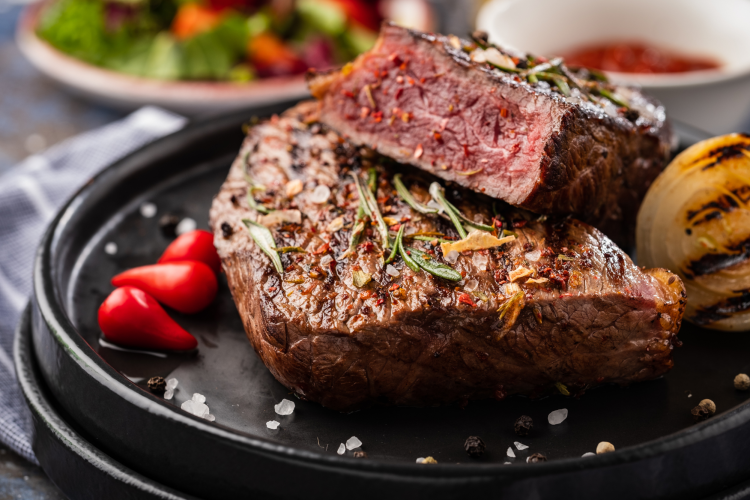
Taste
The slow and even process of sous vide cooking allows meats to tenderize and retain their moisture when prepared with this technique. Cheaper, tougher cuts of meat can be transformed by sous vide into juicy and succulent dishes. Depending on the desired results, the chef can control the time and temperature to prepare anything from a meaty, juicy steak to fall-off-the-bone tender pork shoulder.
Vacuum sealing can also help to concentrate flavors when proteins or vegetables are sealed inside the bag and infused with marinades, sauces, herbs or spices.
Flexibility
Sous vide cooking is the modern version of set it and forget it food preparation, offering increased flexibility while making meals. The home cook can prepare other elements of the meal while food cooks in the sous vide machine or prepare proteins or vegetables that are fully cooked ahead of time, ready to be incorporated into a last-minute weeknight dinner.
Sous vide cooking is extremely forgiving, so the chef does not have to hover or even pay close attention to the food during the sous vide process and still end up with thoroughly and evenly cooked food.
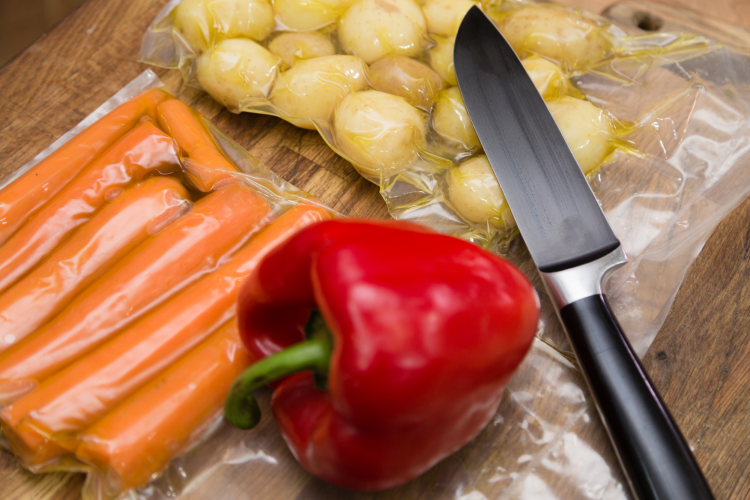
Efficiency
Sous vide cooking is patient and holds food at the desired temperature until the chef is ready to finish and serve. This is one reason sous vide is so popular in professional kitchens.
Chefs can prepare several otherwise time-consuming proteins ahead of time to the point of needing only to remove them from the bag and sear before serving. Sous vide cooking is also a great technique for meal prep routines as you can prepare food ahead of time that will keep fresh in its airtight bag often for several days until it is ready to be eaten.
Best Things to Sous Vide
Red Meat
Red meats such as beef, lamb and venison are popular choices for sous vide cooking. Because this technique helps reduce shrinkage during the cooking process and retains moisture in the meat, professional chefs and home cooks alike enjoy preparing red meat with sous vide.
Temperature control allows cooks to consistently bring the meat to a preferred temperature (medium-rare, for example) and hold the meat at that temperature until it is ready to be seared and served.

Chicken
There are few things that ruin a dish faster than poorly cooked chicken, whether it is dry, tough and overcooked, or not cooked enough and unsafe to eat. Sous vide cooking helps avoid both of these disasters, leaving you with juicy, thoroughly cooked chicken.
Pork
From hefty chops to a hearty roast, pork responds well to sous vide cooking. Thanks to precision control over time and temperature, this technique can produce tender pork for sandwiches, tacos or your Sunday roast dinner.

Eggs
The ubiquitous egg truly is a workhorse of the kitchen, and sous vide cooking even further expands the possibilities for this humble protein. Cooking eggs at a temperature of 130°F allows the eggs to sterilize without coagulating to ease the fears of those who worry about using raw eggs in applications such as mayonnaise or dressings.
Sous vide allows chefs to achieve textures with eggs that are nearly unattainable with other cooking methods, such as the soft, custard-like sous vide egg bites that have become a popular on-the-go breakfast item. Poached and soft-boiled eggs are easily achieved with sous vide, as well as creamy hollandaise and luscious custards.
Seafood
Sous vide is a nearly fool-proof way for aspiring cooks to prepare expensive seafood without fear of ruining that succulent lobster or fresh salmon. Because seafood normally cooks quickly, it is very easy to overcook and difficult to infuse with flavor. Like other proteins, seafood can be temperature-controlled and marinated or seasoned in the bag for tender and flavorful results.
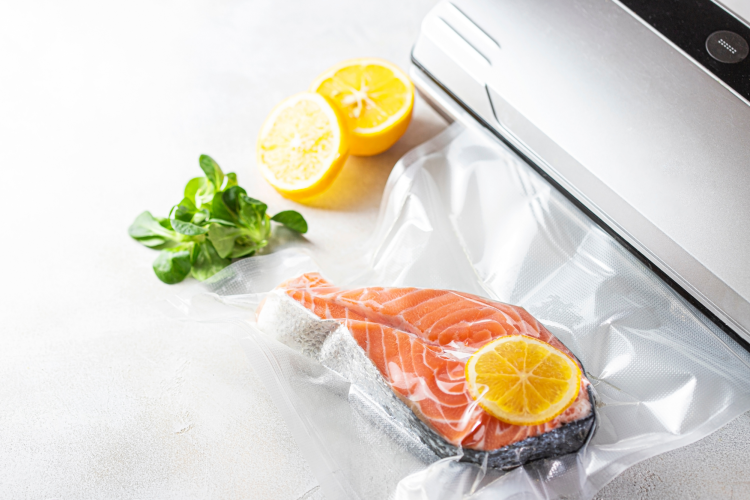
Vegetables
All types of vegetables from potatoes, carrots and beets to broccoli, cabbage and asparagus are candidates for sous vide cooking. This technique is an excellent choice for cooking vegetables with the benefits of a tender yet crisp texture, color retention and nutrient preservation.
Because the vegetables are not cooked above a temperature that fully breaks down the cell walls, sous vide cooking tenderizes the vegetables without compromising their structure and the airtight bag catches any nutrients that are released during the cooking process.
Common Sous Vide Mistakes
Not Fully Submerging the Bag
It is critical to keep the bag fully submerged throughout the process of sous vide cooking. If the bag is not fully submerged or does not stay submerged during the entire cooking time, you risk having unevenly and undercooked food because the water is unable to circulate around and heat the entire contents of the bag.
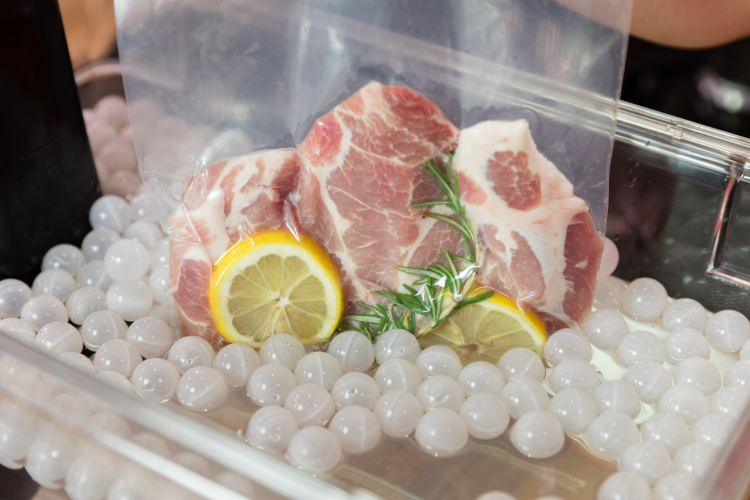
Not Using Enough Water
Using enough water helps make sure the bag is fully submerged throughout the entire cooking process. Keep in mind that water will evaporate over time, so make sure to use enough to last throughout the entire cook time.
Mishandling Bags
In order to keep your food from becoming waterlogged, it is critical to check and double-check that the bags are properly sealed. Be wary of using sharp tools like forks or tongs when handling the sealed bags, as they can easily be punctured by sharp equipment.
Similarly, make sure to use the correct type of bags when using sous vide. Although a plastic zip bag might work in a pinch, the best results come from vacuum-sealed bags that are designed for this cooking technique.
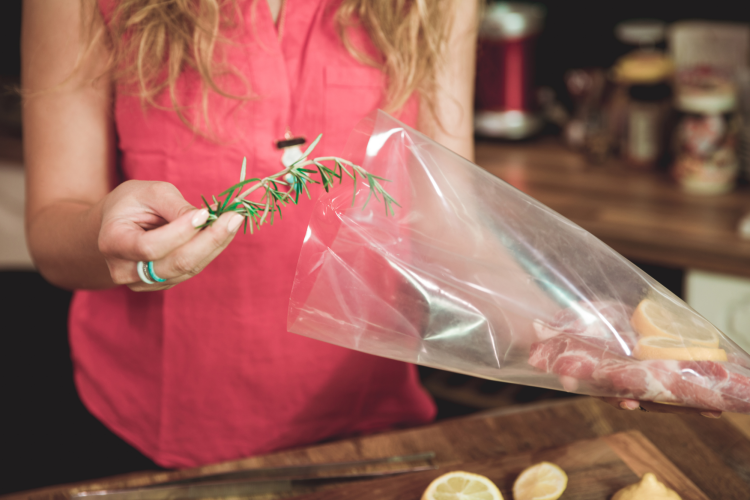
Setting the Wrong Temperature
Temperature is absolutely key when it comes to sous vide cooking. Make sure you are heating your food to the appropriate temperatures for safe consumption, especially in the case of chicken or pork.
Also, consider adjusting the temperature to account for reheating your food if you do not plan on enjoying it immediately. Although it is difficult to overcook food using this process, it can happen, so make sure to reference the times and temperatures in recipes if you are just starting out.
Cooking Different Foods Together
Just as you wouldn’t cook a steak at the same time and temperature as asparagus or potatoes, you should not necessarily cook different types of food in the same sous vide bag. To achieve the desired textures and temperatures, the time and settings of the sous vide should be attentively programmed to match the food you are trying to cook. A pork roast will take much longer than some marinated carrots.
Similarly, some items should be pre-cooked before going into sous vide, as this process can intensify the flavors of herbs and seasonings. For example, garlic should be cooked before going into the bag with other foods in order to avoid the intense flavor of raw garlic permeating your dish.

Not Properly Finishing Meat
One of the downsides to sous vide cooking is that the cooked food can appear bland and gray without that inviting sear or crunch on the outside. The final step of searing your meat in a hot pan keeps the meat moist while giving it that finishing touch.
Home cooks who want to experiment with a new culinary technique, easily prepare food ahead of time for quick lunches or dinners, and create restaurant-quality dishes in their own kitchens should give sous vide cooking a try. With only a few pieces of equipment, you can explore the possibilities of sous vide at home, from tender, juicy steaks to luscious, jammy eggs.
For even more ways to elevate your kitchen, check out chef-recommended cookware in the Cozymeal Shop.
